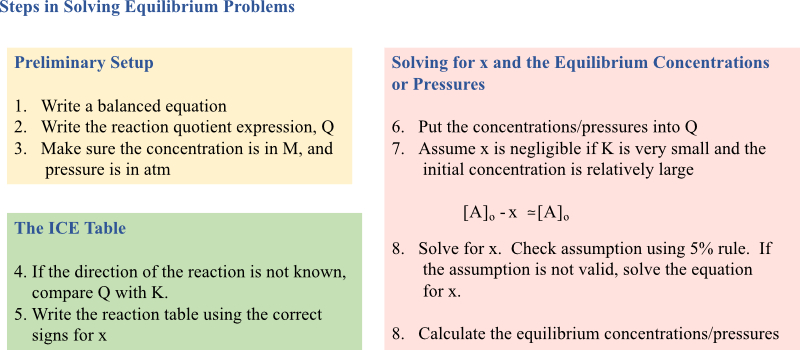Consider the following reaction:
The initial concentration of N2 is 0.75 M and O2 is 0.15 M. Kc is equal to 1.0 x 10-5 at 1227 oC. Calculate the equilibrium concentrations of all species.
Set up the ICE table.
Put the equilibrium concentrations into the equilibrium constant expression.
From the equation it looks like we can only solve for x with the quadratic formula. But, the value of k is very small — 1.0 x 10-5 — when comparing to the initial concentrations. In other words, the amount of x that is subtracted from the initial concentrations, is not going to affect the initial concentrations. This means we can assume x is negligible, and we can neglect it. Our equilibrium constant expression becomes:
We will make the assumption that 0.75 – x ≈ 0.75 M and 0.15 – x ≈ 0.15 M. We will check the assumption using the 5% rule after we solve for x.
Next, we need to check our assumption using the 5% rule. We divide x by the initial concentration and multiply by 100. If the answer is less than 5%, the assumption is valid. If it is 5% or greater, the assumption is not valid and the quadratic formula must be used to calculate x.
Check, using the 5% rule for nitrogen and oxygen.
0.071% < 5% so our assumption was valid. Now we check for oxygen.
0.35% < 5% and our assumption was valid. The assumptions introduced an error of less than 5%. We can now calculate our equilibrium concentrations.
[N2]eq = 0.75 M – 5.3 x 10-4 M = 0.75 M
[O2]eq = 0.15 M – 5.3 x 10-4 M = 0.15 M
[NO]eq = 2 x (5.3 x 10-4 M) = 0.0011 M
In summary, if K is relatively small and [A]o (the initial concentration) is relatively large, use the 5% rule to calculate x. Always check your assumption. To determine if the 5% rule can be used, you can divide the initial concentration by K, and if it is greater than 400, less than 5% error will be introduced.
\(\displaystyle \text {If}\;\frac {[A]_o}{K_c}\;>\;400\;\;\text{assumption is justified, neglecting x will result in less than 5% error}\)
If x is neglected, always check your assumption using the 5% rule. See the figure below for steps on how to solve equilibrium problems.
Watch the Following Videos
Solving Equilibrium Problems Part 1
Solving Equilibrium Problems Part 2
Solving Equilibrium Problems Part 3
Solving Equilibrium Problems Part 4
Solving Equilibrium Problems Part 5
Solving Equilibrium Problems Part 6
Exercises
Exercise 1. The following reaction has Kc = 4.60 x 10-3 at a certain temperature.
N2O4 (g) ⇄ 2 NO2 (g)
The initial concentration of N2O4 was 3.60 M. What are the concentrations of N2O4 and NO2 at equilibrium?
Check Answer/Solution to Exercise 1
Exercise 2. The following reaction has Kp = 0.0503.
2 Fe (l) + 3 CO2 (g) ⇄ Fe2O3 (s) + 3 CO (g)
Calculate the pressures of all gas species at equilibrium if the initial pressure of CO2 was 28.25 atm.
Check Answer/Solution to Exercise 2
Exercise 3. What are the equilibrium concentrations of all species in a 0.45 M NH3 solution?
NH3 (aq) + H2O (l) ⇄ NH4+ (aq) + OH– (aq) Kc = 1.8 x 10-5
Check Answer/Solution to Exercise 3
Exercise 4. Calculate the equilibrium concentrations of all species if the initial concentration of HCN is 0.25 M.
HCN (aq) ⇄ H+ (aq) + CN– (aq) Kc = 4.9 x 10-10
Check Answer/Solution to Exercise 4
Exercise 5. The following reaction has Kc = 4.60 x 10-3 at a certain temperature.
N2O4 (g) ⇄ 2 NO2 (g)
The initial concentration of N2O4 was 0.500 M. What are the concentrations of N2O4 and NO2 at equilibrium?
Check Answer/Solution to Exercise 5
Back to Chemical Equilibrium
Back to General Chemistry 2 Study Guides

